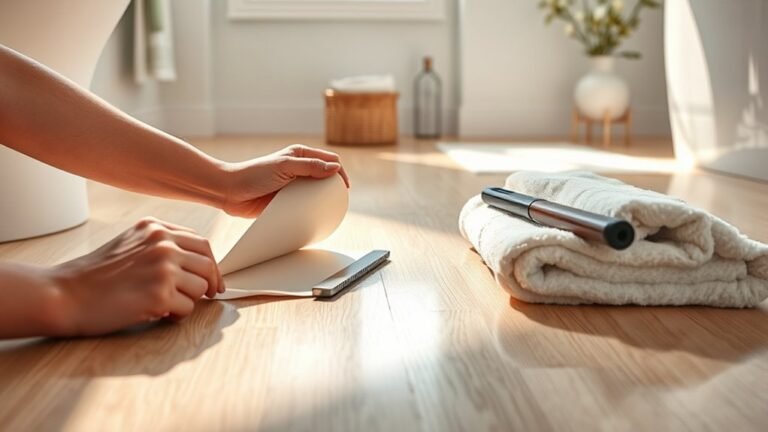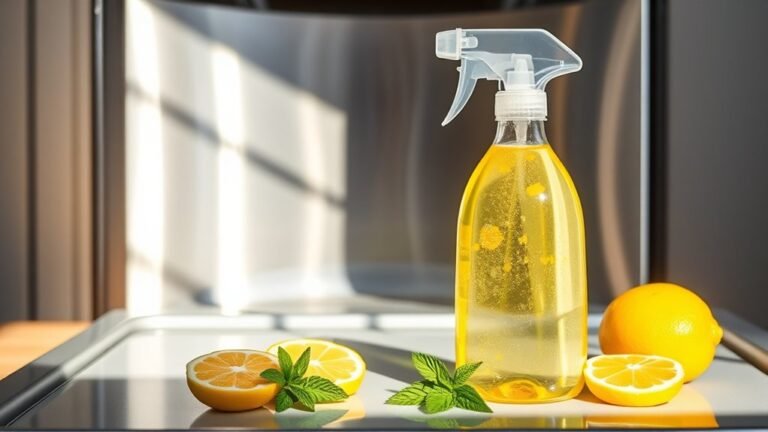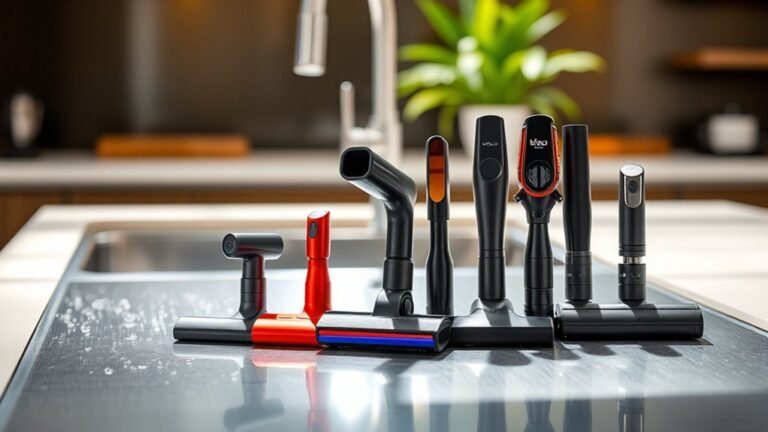Preventing Dirt Buildup on Microwave
You can prevent dirt buildup in your microwave by cleaning it regularly—ideally once a week—and wiping spills immediately to avoid hardened residue. Use microwave-safe covers during cooking to minimize splatter, and choose non-abrasive, natural cleaning products like vinegar or baking soda for safe maintenance. Steam cleaning loosens grime efficiently, and removing the turntable for separate cleaning helps too. Regularly check vents to guarantee proper airflow and odor control. Keep exploring these methods to maintain peak microwave performance.
Regular Cleaning Schedule for Microwaves

Although it might seem tedious, sticking to a regular cleaning schedule for your microwave is essential to prevent dirt buildup and maintain top performance. Establishing an ideal cleaning frequency depends on your usage intensity, but generally, cleaning once a week is practical. You can adjust this interval based on how often spills or splatters occur. To maintain consistency, incorporate scheduling reminders on your phone or calendar app. These prompts guarantee you don’t overlook this task, preserving your microwave’s efficiency and lifespan. Regular cleaning prevents residue accumulation that might impair heating uniformity and generate unpleasant odors. By adhering to a disciplined cleaning routine and using scheduling reminders, you gain control over maintenance without sacrificing your freedom, keeping your microwave hygienic and fully operational with minimal effort.
Using Microwave-Safe Covers During Cooking
Using one or two microwave-safe covers during cooking can considerably reduce splatters and prevent dirt buildup inside your microwave. These microwave safe lids act as a barrier, containing steam and food particles that would otherwise disperse and cling to the microwave’s interior surfaces. By employing proper food splatter prevention techniques with these covers, you maintain a cleaner environment, reducing the frequency and intensity of cleaning sessions. When selecting microwave safe lids, make sure they are designed to withstand microwave heat without melting or releasing harmful chemicals. Transparent covers with vent holes are ideal—they allow steam to escape, preventing pressure buildup while keeping splatters contained. Incorporating microwave-safe covers into your routine grants you more freedom, as you spend less time scrubbing and more time enjoying hassle-free cooking.
Wiping Down Spills Immediately

Whenever a spill occurs inside your microwave, wiping it down immediately prevents residue from hardening and becoming more difficult to remove. Taking immediate action is essential for effective spill management, as dried food particles can cause odors and interfere with the microwave’s performance. Use a damp cloth or sponge to carefully clean the affected area right after use, avoiding abrasive materials that could damage the interior surfaces. Prioritize quick response to contain spills before they spread or attract pests. By integrating this habit into your routine, you maintain a hygienic environment and extend the appliance’s lifespan. Consistent immediate spill management reduces the need for intensive cleaning sessions, giving you more freedom to focus on daily tasks without the burden of stubborn microwave grime.
Choosing the Right Cleaning Products
You’ll want to pick non-abrasive cleaners to protect your microwave’s surfaces from scratches. Natural alternatives like vinegar or baking soda offer effective cleaning without harsh chemicals. Avoid products with strong acids or bleach, as they can damage the interior and affect performance.
Non-abrasive Cleaners
Although it might be tempting to reach for strong chemicals, selecting non-abrasive cleaners is crucial to protect your microwave’s surfaces from scratches and damage. You should opt for mild detergents or specialized microwave-safe cleaning solutions that won’t degrade the interior finish. When cleaning, use non abrasive sponges designed to lift dirt without scratching. Combine these with gentle scrubbing techniques to avoid wearing down the protective coatings. Avoid harsh scouring pads or abrasive powders, as they can cause micro-abrasions that trap dirt and accelerate deterioration. Consistent use of appropriate cleaners and tools not only maintains the microwave’s appearance but also guarantees its longevity and hygienic operation. Prioritize products labeled safe for delicate surfaces, and always follow manufacturer guidelines for best results.
Natural Cleaning Alternatives
While non-abrasive cleaners help protect your microwave’s surfaces, many users seek natural alternatives that are both effective and environmentally friendly. A vinegar solution, typically one part white vinegar to one part water, serves as a powerful, non-toxic cleaner that dissolves grease and neutralizes odors efficiently. You can enhance this solution by adding a few drops of essential oils like lemon or tea tree, which provide antimicrobial benefits and a pleasant scent without chemical residues. When applying, use a soft cloth or sponge to avoid abrasion. This method lets you maintain cleanliness while minimizing exposure to synthetic chemicals. By choosing these natural products, you maintain your microwave’s integrity and reduce environmental impact—giving you freedom from harsh substances and a safer kitchen environment.
Avoiding Harsh Chemicals
Since harsh chemicals can damage your microwave’s interior coatings and pose health risks, it’s essential to select cleaning products carefully. Opt for eco friendly options that maintain your appliance’s integrity and safeguard your health. Chemical free solutions not only reduce exposure to toxins but also support sustainable living. When choosing cleaning agents, consider:
- Vinegar and water mixtures for effective, gentle degreasing
- Baking soda paste to tackle stubborn stains without abrasives
- Commercially available eco friendly sprays certified for kitchen use
- Avoidance of bleach, ammonia, and other corrosive substances
Steam Cleaning Method for Easy Maintenance
When you want to maintain your microwave with minimal effort, the steam cleaning method offers an efficient solution. Start by filling a microwave-safe bowl with water and adding a tablespoon of vinegar or lemon juice to enhance cleaning power. Place the bowl inside and run the microwave on high for 5–7 minutes, allowing steam to loosen grime and food residues. After the cycle, let it sit for a few minutes before carefully removing the bowl to avoid burns. Use a soft cloth or sponge to wipe down the interior surfaces; the steam will have softened stubborn dirt, making it easy to clean without harsh scrubbing. Incorporating steam cleaning into your microwave maintenance routine reduces buildup effectively, saving you time and preserving the appliance’s condition with minimal effort.
Removing and Cleaning Microwave Turntables

Regularly removing and cleaning your microwave turntable is essential for maintaining hygiene and preventing unpleasant odors. For effective turntable removal, first verify the microwave is off and cool. Gently lift the glass plate and rotating ring out. Turntable maintenance involves thorough cleaning to avoid residue buildup.
Regularly clean your microwave turntable to maintain hygiene and prevent odors by gently removing and washing it thoroughly.
Follow these practical steps:
- Wash the turntable components with warm, soapy water using a non-abrasive sponge.
- Inspect the turntable support and motor coupling for food debris; wipe clean with a damp cloth.
- Dry all parts completely before reassembling to prevent moisture accumulation.
- Replace the turntable correctly by aligning it on the support to guarantee smooth rotation.
This routine supports your microwave’s performance and extends its lifespan.
Preventing Odors With Natural Deodorizers
You can effectively prevent microwave odors by using natural deodorizers like citrus-based fresheners and baking soda solutions. Citrus oils neutralize odors while adding a clean scent, and baking soda absorbs lingering smells without harsh chemicals. Applying these methods regularly helps maintain a fresh microwave environment.
Citrus-Based Fresheners
Three simple citrus-based fresheners can effectively neutralize microwave odors without introducing harsh chemicals. Utilizing citrus peels and essential oils harnesses natural deodorizing properties, making your microwave maintenance both eco-friendly and efficient. You can try these methods:
- Simmer lemon or orange peels in water inside the microwave for 3-5 minutes, allowing steam to loosen dirt and absorb odors.
- Place a few drops of citrus essential oils on a damp cloth and wipe down the microwave interior.
- Create a citrus vinegar spray by mixing water, white vinegar, and lemon essential oil for targeted odor elimination.
- Keep dried citrus peels in a small open container inside the microwave (when off) to maintain a fresh scent.
These solutions provide a chemical-free approach to prevent lingering odors and dirt buildup.
Baking Soda Solutions
Building on natural deodorizing methods like citrus fresheners, baking soda offers another effective way to prevent odors in your microwave. You can create a baking soda paste by mixing baking soda with a small amount of water until it reaches a spreadable consistency. Apply this paste to microwave surfaces prone to odor buildup and let it sit for 10-15 minutes. For tougher grime or lingering smells, use a baking soda scrub by combining baking soda with water to form a gentle abrasive. Scrub microwave interiors carefully to avoid damaging surfaces, then wipe clean with a damp cloth. These approaches neutralize acidic and basic odor molecules, maintaining a fresh environment. Incorporating baking soda paste or scrub regularly guarantees your microwave stays odor-free without harsh chemicals, giving you freedom from persistent smells and residue.
Inspecting and Maintaining Microwave Vents
Although often overlooked, inspecting and maintaining microwave vents is essential for peak appliance performance and safety. Regular vent inspection helps prevent dirt buildup that can obstruct airflow, causing overheating or reduced efficiency. To keep your microwave vents in prime condition, focus on these key maintenance tasks:
Regularly inspecting microwave vents prevents dirt buildup, ensuring optimal performance and safety.
- Remove and clean vent covers using a mild detergent to eliminate grease and dust.
- Check for blockages inside the vent path and clear any debris carefully.
- Verify the fan operates smoothly without unusual noises or resistance.
- Schedule periodic professional vent maintenance to address hard-to-reach areas.
Frequently Asked Questions
Can Microwave Liners Prevent Dirt Buildup Effectively?
You’ll find microwave liners effective for dirt prevention because they create a barrier that catches spills and splatters during heating. By placing these liners inside your microwave, you minimize direct contact with food messes, making cleanup quicker and easier. Just guarantee you choose liners made of heat-resistant, non-toxic materials. This practical approach gives you freedom from frequent scrubbing while maintaining a clean microwave interior efficiently.
How Does Microwave Wattage Affect Cleaning Frequency?
Microwave power directly impacts how often you’ll need to clean your appliance. Higher microwave wattage cooks food faster but can cause more splatters due to intense heating, requiring more frequent cleaning. Conversely, lower wattage means longer cooking times and potentially less mess, so you might clean less often. Adjusting your cleaning habits based on your microwave’s power helps maintain efficiency and prolongs its lifespan, giving you more freedom from constant upkeep.
Are There Any Foods That Cause More Microwave Mess?
You might expect all microwave meals to be equally messy, but spillage prone foods like soups, sauces, and high-fat items cause more splatter than dry or solid foods. These liquids heat unevenly, creating sudden bubbles that burst, leading to messes. To maintain microwave freedom, use splatter prevention techniques such as covering dishes with vented lids or microwave-safe wraps. This precise approach minimizes cleaning frequency and keeps your appliance spotless with less effort.
Can Leaving the Microwave Door Open Help Reduce Odors?
Leaving the microwave door open after use can help reduce odor absorption by allowing trapped smells to dissipate more quickly. This practice also aids in moisture retention control, preventing lingering steam that fosters odor buildup. However, make certain the area is clean to avoid attracting dust or pests. So, while it’s practical for odor management, balance it with hygiene and safety for ideal freedom from stubborn microwave smells.
Is It Safe to Use Vinegar Inside Metal Parts of a Microwave?
You shouldn’t use vinegar directly on metal parts inside your microwave, as vinegar’s acidity can corrode metal over time. For vinegar safety and effective microwave maintenance, dilute vinegar with water and apply it using a cloth only to non-metal surfaces. Avoid spraying or pouring vinegar onto metal components to prevent damage. Regular cleaning with appropriate solutions guarantees your microwave stays functional without compromising its metal parts or safety.






